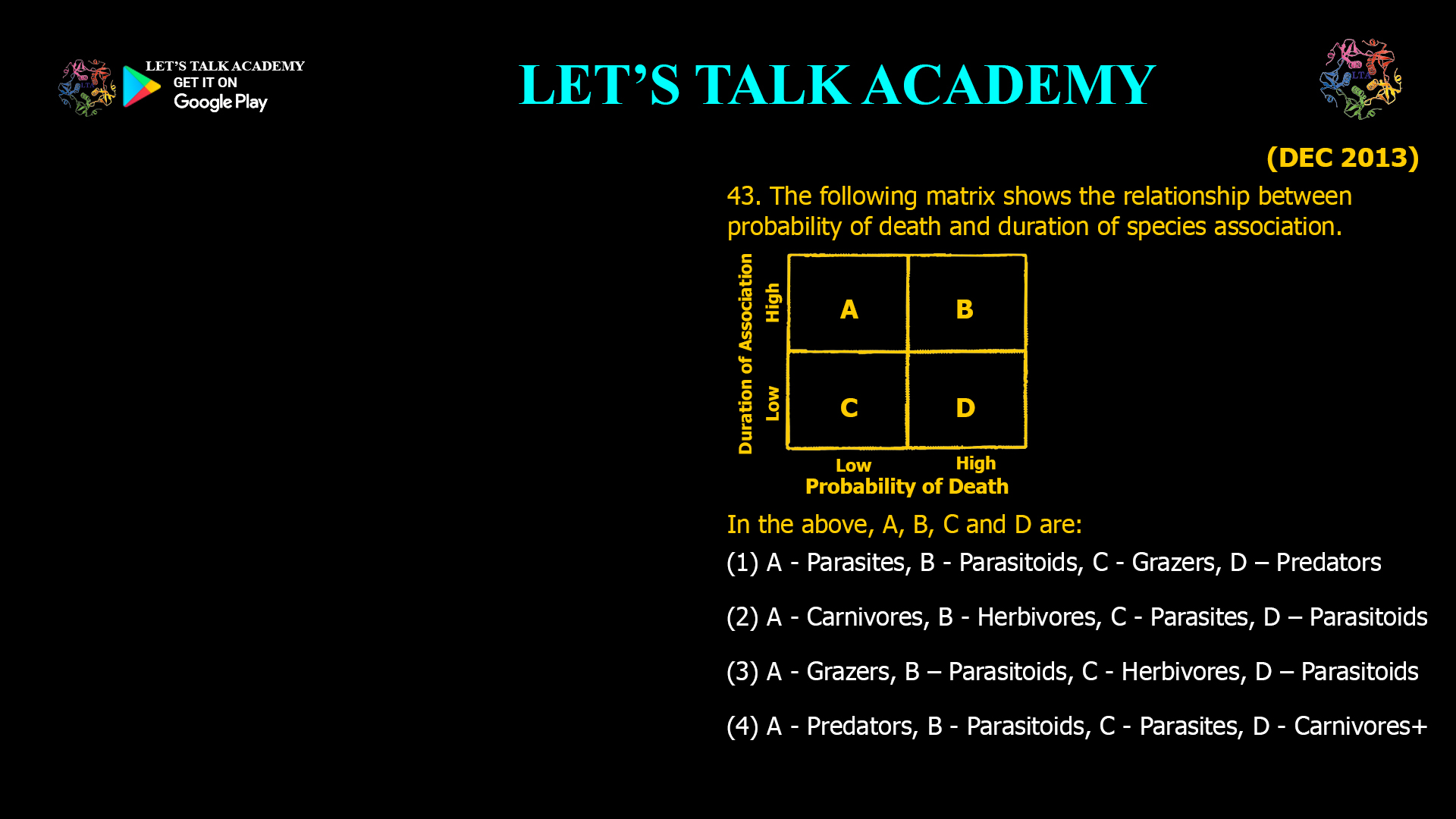- The following matrix shows the relationship between probability of death and duration of species association.

In the above, A, B, C and D are:
(1) A – Parasites, B – Parasitoids, C – Grazers, D – Predators
(2) A – Carnivores, B – Herbivores, C – Parasites, D – Parasitoids
(3) A – Grazers, B – Parasitoids, C – Herbivores, D – Parasitoids
(4) A – Predators, B – Parasitoids, C – Parasites, D – Carnivores+In ecology, the interactions between species—such as predation, parasitism, and grazing—can be analyzed through various models that relate the probability of death of a host or prey to the duration of association with another species. A matrix summarizing these relationships often categorizes species into groups like predators, parasitoids, parasites, grazers, and carnivores based on their ecological roles and effects on their hosts or prey.
The Matrix Context
The matrix in question relates probability of death to duration of species association, reflecting how long a species interacts with its host or prey before causing death. Different ecological interactions exhibit distinct patterns:
-
Predators typically kill their prey quickly after capture.
-
Parasitoids have a longer association, often living within or on the host before eventually killing it.
-
Parasites usually have a prolonged association without necessarily killing the host immediately.
-
Grazers consume parts of the host or plant without causing immediate death.
-
Carnivores are predators feeding on other animals but may have different interaction dynamics depending on the species.
Identifying A, B, C, and D
Based on ecological theory and typical patterns in such matrices:
-
A (High probability of death, short association): This corresponds to Predators, which kill prey quickly.
-
B (High probability of death, longer association): Fits Parasitoids, which have extended interaction before killing the host.
-
C (Low probability of death, long association): Matches Parasites, which often coexist with hosts without immediate death.
-
D (Variable probability of death, association varies): Represents Carnivores, which may have diverse feeding strategies and interaction durations.
Correct Matching Option
Given the options:
-
A – Parasites, B – Parasitoids, C – Grazers, D – Predators
-
A – Carnivores, B – Herbivores, C – Parasites, D – Parasitoids
-
A – Grazers, B – Parasitoids, C – Herbivores, D – Parasitoids
-
A – Predators, B – Parasitoids, C – Parasites, D – Carnivores
The correct answer is:
(4) A – Predators, B – Parasitoids, C – Parasites, D – Carnivores
Explanation
-
Predators (A) cause rapid death, reflected by high mortality probability with short association.
-
Parasitoids (B) have a longer association before host death.
-
Parasites (C) maintain a prolonged, often non-lethal relationship.
-
Carnivores (D) include diverse feeding behaviors, sometimes overlapping with predators but with variable interaction times.
Ecological Significance
Understanding these distinctions helps ecologists:
-
Predict population dynamics based on interaction types.
-
Model ecosystem stability and species coexistence.
-
Develop conservation strategies considering species roles.
Conclusion
The matrix relating probability of death and duration of species association is a powerful tool in ecology. Correctly identifying the roles of predators, parasitoids, parasites, and carnivores clarifies the nature of species interactions and their impact on ecosystems.
Answer: (4) A – Predators, B – Parasitoids, C – Parasites, D – Carnivores
-




2 Comments
Kajal
November 9, 2025Option 1
Sakshi Kanwar
November 27, 2025) A – Parasites, B – Parasitoids, C – Grazers, D – Predators